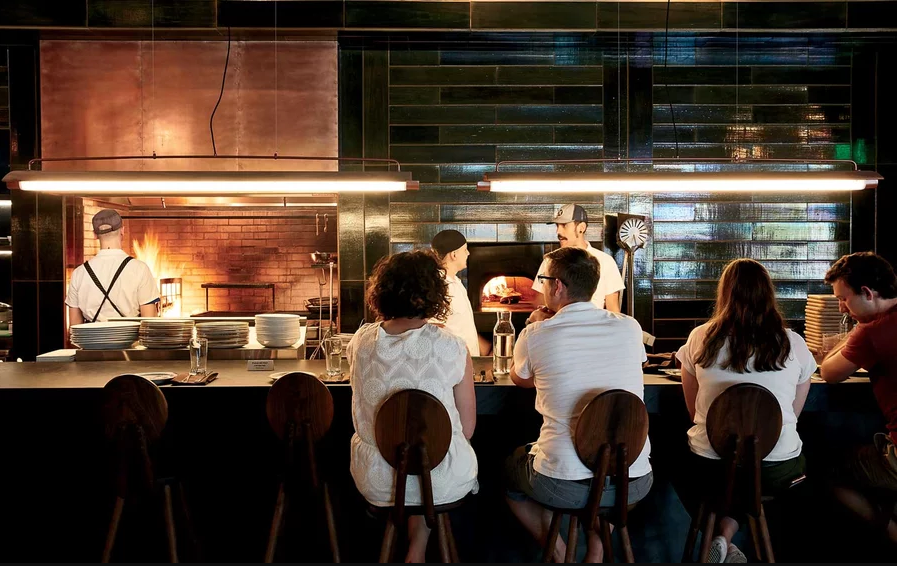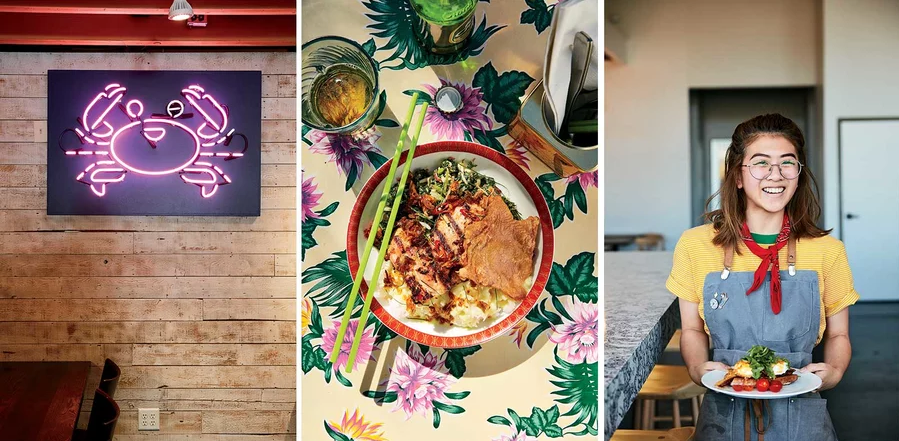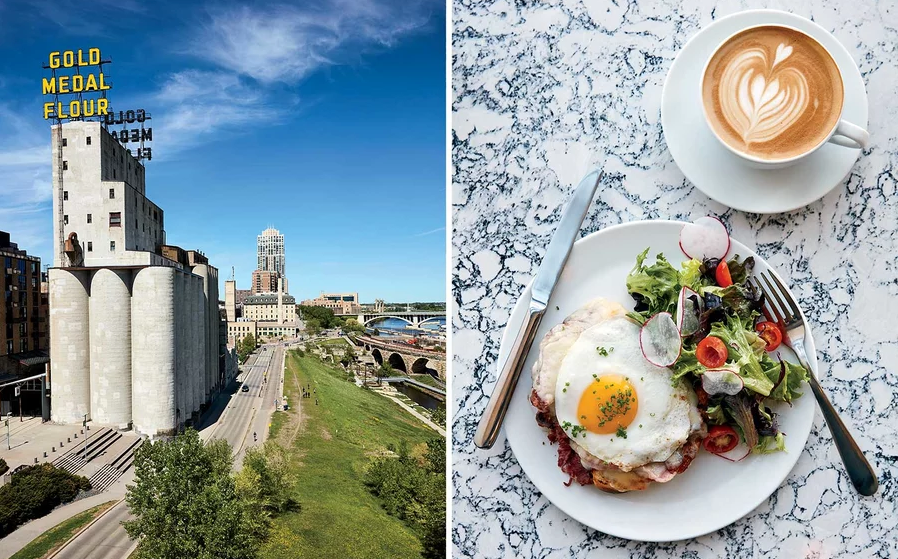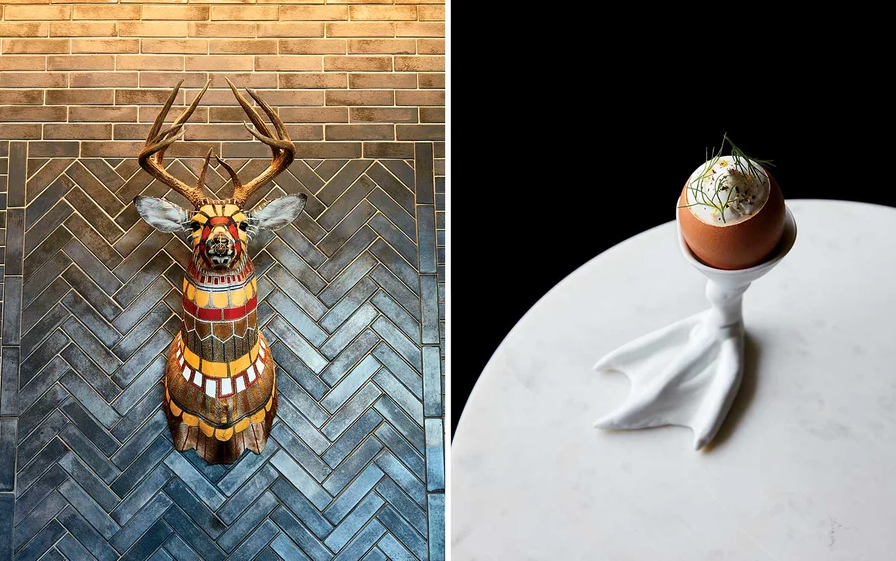Why Every Food Lover Should Visit the Twin Cities
Minnesota’s Twin Cities are forging a new identity, one that celebrates the region’s Nordic past while embracing its multicultural present
/https://tf-cmsv2-smithsonianmag-media.s3.amazonaws.com/filer/b2/a1/b2a11d49-9472-4a2e-a261-9fe2985bb95b/screen_shot_2018-08-21_at_125429_pm.png)
Let's talk about the sweet potatoes at Young Joni. How they're blackened like campfire marshmallows, the insides all gooey and sweet. How they're spiked with gochugaro and topped with barely-there ruffles of bonito flakes. And, underneath it all, clinging to the plate, an enlightened schmear of crème fraîche and smoky charred scallions.
And, sure, let's talk about how the mushrooms are freakishly juicy — water-balloon juicy — because they're confited in olive oil before they hit the grill. Or how my favorite of Minnesota's embarrassment of lakes is the miniature one made of chestnut-miso butter pooled beneath those plump mushrooms.
We could talk this way about a lot of what's coming off the wood fire at this handsome Korean-ish pizza-and-other-stuff restaurant in the artsy, low-slung Minneapolis neighborhood of Northeast. But I'm inclined not to belabor the thesaurus-taxing explications and dutiful prepositions of the professional food describer (this thing atop that one, and a dollop of something else) and just say it directly: this stuff is really good. Get here and eat it if you can. Even if that means strapping on a pair of cross-country skis and braving the whiteout of a freak spring blizzard, as it did for some undeterred Young Joni devotees just before I visited in late April.
"I want you to walk in here and feel like the restaurant is giving you a big hug," said Ann Kim, chef-proprietor of the two-year-old establishment, who also runs Pizzeria Lola and Hello Pizza, in Southwest Minneapolis. Call it Korean-Midwestern hygge. Call it the embrace of fire and spice by an often-freezing city newly hip to the multidimensional tastes of its increasingly diverse populace. Call it the embodiment of quirky, cosmopolitan Minneapolis, St. Paul's ever-so-slightly showier younger sibling. Whatever it is, it's working. The place was packed to the wood-beamed rafters. Guests ordered the amatriciana pizza, a meat-heavy pie called the Yolo, and another topped with fennel sausage, mozzarella, onion, and a dusting of fennel pollen.
Kim grew up in the suburb of Apple Valley in the late 1970s when, it's fair to say, the full spectrum of the Asian pantry had not yet permeated the markets or mindshare of America's Casserole Belt. With her parents working, her grandmother ran and fed the household.
"Every November, we'd help her make enough kimchi to last the year," Kim said. "The only vessel we had that was big enough was our plastic kiddie pool. She'd let the cabbage brine in there, and then, in summer, my sister and I would clean out the pool and swim in it again."
Another pizza served at Young Joni comes topped with arugula and Korean barbecue, which Kim served at Lola as a lark years ago. "For some people, their first experience with Korean food is on top of a pizza pie — I love that."
**********
In 1850, the Swedish novelist Fredrika Bremer toured the territory that eight years later would become a state and declared prophetically: "What a glorious new Scandinavia might not Minnesota become!"
And so, over the next century or so, it kind of did. Swedes and Danes and Norwegians joined Germans, Italians, and other settlers. The power of the St. Anthony Falls was harnessed, and the flour-milling industry blossomed on the shores of the Mississippi River. Minneapolis and its next-door neighbor, St. Paul, grew large and prosperous, and everyone agreed, in their Midwestern, non-braggadocious way, that they were pretty nice places to live if you didn't mind the winter. Hubert Humphrey and Walter Mondale's presence on the national stage gave the Twin Cities a reputation as a bastion of liberalism, even as they remained mostly white.

But in more recent decades, the demographics have shifted. The Twin Cities have benefited from a transformative influx of immigrants from Mexico, Korea, and Vietnam, among others. Hmong refugees from Laos and Thailand began arriving in the mid 1970s. Today, there are thriving populations of Somalians, Liberians, and Ethiopians, and a dynamic South Asian community. The state's foreign-born population has more than doubled since the early 1990s.
Sitting at Young Joni's bar, I was joined by Cameron Gainer, an artist and publisher of a literary arts-and-culture quarterly called the Third Rail. Gainer came to town a decade ago from New York, when his wife, Olga Viso, took over as executive director of the Walker Art Center.
"Back then, it was difficult to find anywhere to go after 8:30," Gainer said. "I'd tell people where we'd moved and they'd say, "Oh, Milwaukee's great!"" Now, he explained, living here feels like being at the center of something rapidly expanding and evolving: a vibrant creative class; a community of engaged artists, architects, and chefs. An American city like no other.

Andrew Zimmern, host of Bizarre Foods and outspoken booster of his adopted hometown, added to the list of reasons to love this place: "Prince was from here. You can swim, sail, or canoe on our lakes — on your lunch hour. We have the Minnesota State Fair, the single greatest party on planet Earth. And we've gone from not having a single oyster bar in town to being a national powerhouse as a restaurant city. All in one generation."
The Twin Cities' pioneering cultural institutions have continued to reinvent themselves. The Walker, which was reclad and expanded in 2005 by Herzog & de Meuron, last year completed a lengthy overhaul of its iconic sculpture garden, adding 18 new works by artists such as Katharina Fritsch and Theaster Gates. The 55-year-old Guthrie Theater unveiled a striking new Jean Nouvel–designed home in 2006, with its Endless Bridge cantilevered out toward the Mississippi. St. Paul's Minnesota Museum of American Art is in the midst of a massive expansion. Also last year, the century-old Minneapolis Institute of Art put on the first major exhibition of contemporary Somalian artwork. Artists have colonized the industrial buildings of Northeast Minneapolis, converting the brick husks into studios and galleries. This dynamic cultural scene is by design: Minnesota ranks second in the nation after Washington, D.C., for per-capita government spending on the arts. "There's a let's-make-stuff vibe that's amazing," Gainer said. "There are opportunities to collaborate, to do things that don't exist yet, like start an art journal or open a Korean pizza joint."
"Give us one fried-chicken sandwich as a garnish, please," Sameh Wadi said. We were wearing plastic bibs and slurping frozen daiquiri slushies at Grand Catch, the bright and buoyant Asian-style Cajun seafood-boil restaurant that he and his brother Saed just opened with Thien Ly, a Vietnamese chef, on St. Paul's leafy Grand Avenue.
Sameh, a Palestinian-American chef and restaurateur with a general air of mischievous merriment, was ordering lunch for the two of us. The sandwich, he emphasized, was a mere palate cleanser to be shared between the main events: copious platters of pungently spiced crawfish, corn, gangly shrimp, and a Dungeness crab the size of a large chihuahua, whose carapace we'd lift and drink from as if it were a sacred chalice filled with brothy crab-innard delights.
He met Thien Ly when a friend brought him to Cajun Deli, Ly's hole-in-the-wall seafood-boil spot in suburban Brooklyn Park. For Sameh, who'd opened and closed a Middle Eastern fine-dining restaurant and moved on to run an eclectic street food truck and restaurant called World Street Kitchen ("burritos with fried rice and curry chicken, shawarma tacos — everything's delicious and makes no sense"), the border-bending Viet-Cajun boil was a revelation.
"It burned my face, but it's so addicting," he said. Returning obsessively for years, he got to know Ly. Eventually, he and the Wadi brothers talked shop and decided to open one.

And here we were, bibbed and broth-splattered, drinking pink slushies in coupe glasses in this bright spot on a flush avenue, and there was a neon sign on the wall that read WHAT'S CRACKIN? and crab dip with fermented crab paste and Middle Eastern spices and an ice-cream machine nicknamed Betty Lou that dispensed raspberry-lychee soft serve to help cool the burn. I kept forgetting what state or country I was in — and hoping I didn't have to leave.
I wondered, were the Twin Cities ready for this 10 years ago? "Absolutely not," Sameh said. "Ten years ago, people weren't ready for my white-tablecloth Middle Eastern restaurant with foie gras on the menu. Now people are just game. Now you can go to a Vietnamese restaurant, and they're doing Minnesota walleye in clay pots. It's a gorgeous thing."
**********
"Last week people were so angry!" the chef Gavin Kaysen said with a laugh. Happily, I'd missed the late-season blizzard. The Great Thaw had come to the Cities and nobody seemed angry about anything.
Kaysen's restaurant, Spoon & Stable, is in Minneapolis's North Loop, a fast-changing riverfront neighborhood of broad avenues, where old stables and warehouses are now populated by start-ups and coffee bars. A Minnesota native, Kaysen left for a decade or so to work in Napa Valley and New York City, where he ran kitchens for Daniel Boulud and won a James Beard Award. When he came home in 2014, he had a sense that the city's restaurant scene was ready for its close-up. There's been a line out the door for his impeccable modern American food with regional ingredients (bison tartare with watermelon radishes; birch-smoked cobia; pea-leaf fusilli with lamb and morels) ever since.

I met Kaysen and his pastry chef, Diane Yang, a first-generation Hmong-American, at Hmong Village, where we ate chicken wings stuffed with vermicelli noodles and ogled bitter melon vines. I’d arrived at the market with Carolina barbecue sauce on my shirt, slightly sauced myself on Old Fashioneds made with Dr. Pepper syrup and a proprietary bourbon peculiar to the restaurant Revival, in another part of St. Paul. There, I’d received useful instruction from Thomas Boemer in both the proper coloring of North Carolina-style fried chicken (“golden retriever slash labradoodle”) and the subtle differences between Minneapolis and St. Paul. Thomas grew up in the South, but his family is old St. Paul blood. It’s here he and his business partner run a group of Revivals and are opening a gigantic Basque-inspired live-fire restaurant, food market, and event space in the soon-to-be-revitalized Keg & Case warehouse next to the historic Schmidt Brewery in the Bluffs. “You’re not going to see a cat café here,” Boemer said, a subtle dig at flashier, more cosmopolitan Minneapolis which has, in point of fact, just opened its first cat café. “I was going to go, but my wife gave shamed me out of it.”
I mention the barbecue sauce at Hmong Village not just to emphasize that it had been a busy period of eating. (As the hometown hero Prince sang under different circumstances, "Touch if you will my stomach/Feel how it trembles inside.") Taken together, the Twin Cities today are less a New Scandinavia and more a varied, singularly American cultural smorgasbord.
Another thing that's changed is the embrace of winter. Eric Dayton and his brother, Andrew, sons of Minnesota governor Mark Dayton and vocal supporters of modern Minnesota, own the men's boutique and lifestyle brand Askov Finlayson, which has the motto "Keep the North Cold." The Daytons are among those working to rebrand the state as the "North" and reposition its famously cold winters as a point of pride.
Eric recalled a trip to Copenhagen at a time when the global spotlight was on all things Nordic. "I thought we had a lot of the same strengths in our city and our state, yet we were getting written off as flyover country," he says. "We had allowed the rest of the country to tell our narrative for us." The effort started with a line of beanies emblazoned with NORTH. Now Eric is among the leaders of the midwinter Great Northern festival, a 10-day food-and-activity-filled celebration that unites three of the Twin Cities' most popular cold-weather events: St. Paul's winter carnival, a cross-country ski festival, and the U.S. Pond Hockey Championships. (Tagline: "Hockey. The Way Nature Intended.")
What are we getting wrong about this place, I — East Coast outsider, air-dropped in to tell this place's story because we'd heard there was good food and endless cultural diversions — asked, a little sheepishly.
"When I went off for college, people I'd meet would tell me they'd seen Fargo," Eric said. "I don't think we get credit for what a vibrant city this is, the strength of the creative community, the dining scene, and world-class museums. These things get overlooked when it gets lumped in with this catchall idea of the region."

For a sense of the changing face and can-do spirit of the North, head over to artisan glassblowing factory Hennepin Made and Parallel, the sleek espresso bar inside. Jackson Schwartz, a friend of Kaysen's, trained in glassblowing in Australia but came back to make his mark in Minnesota.
"I don't want to compete at a level of what Minneapolis has to offer," Schwartz told me. "I want to compete on an international level. If you walked into this café in Amsterdam or Seattle or wherever, you'd think, Okay, this fits here. This is the place to be. That's the level I want to be at."
Another glimpse of the new can be found at the Hewing Hotel in the North Loop, a recent arrival that has the familiar hallmarks of a hiply converted industrial building (the exposed brick walls, the naked light bulbs), along with bear-patterned wallpaper and framed axes. There's a fireplace in the lobby and a rooftop spa pool that converts to a hot tub in the winter. It's a stylized Paul- Bunyan-goes-to-Brooklyn kind of atmosphere that might feel hokey were the Hewing not housed in a former farm-machinery warehouse, in a city still in touch with its outdoorsy, hunting-fishing-axe-wielding side.
I'd come to the Twin Cities to wander their side streets and waterfronts and to feast on the fat of their land. At Grand Café in South Minneapolis, I feasted, tiny fork in hand, on the fat itself. Described on the menu, simply and weirdly, as "Beef fat slowly roasted in bay leaf," the dish is a lip of fat from a rib eye, gently poached with rosemary and thyme and bay leaf, then rolled and cut and served warmish. Jamie Malone (chef, owner, soft-spoken enabler) had upgraded the situation with caviar that crowned nickel-size disks of opaline fat. On paper, it sounds like comical overkill. In actuality, it's just really nice, understated (if caviar-topped fat can be understated), and suave. Which pretty much sums up this generous, comfortable but not grandly proportioned dining room and everything Malone's doing in it.
Next, because I am an adult and can eat whatever I want even if it kills me, I ordered the Paris-Brest pastry filled with chicken-liver mousse, a recent cover star for this publication's sister magazine, Food & Wine. The choux was crisp, burnished with a glaze made of black honey and luster dust (which sounds like something you'd encounter in the loo of a louche 70s Parisian nightclub, but is actually a product bakers use to make their cupcakes sparkle). Was it good? It's an uppity, sweet, salty, fatty, crunchy, creamy, savory doughnut that's luster-dusted Instagram gold. Bien sûr, it was very, very good.

The Grand Café is descended from a bakery that opened on these premises in 1951. Fifteen years ago it morphed into a café with a neighborhood following and minimal culinary aspirations. When Malone took over last year, she was committed to not sprucing the place up any more than she needed to. The walls are dusky pink, the wood tables uncovered, the tin ceiling hasn't been tended to in a while. The effect of the whole is quietly chic, a captivating, relaxing space that doesn't try too hard to be any one of those things.
"I want people to feel transported. I want it to feel whimsical," Malone said. "And — this is going to sound really stupid — I want you to feel genuinely cared about, because there's a lot of love and respect in this room. Oh, and I want it to feel like a Wes Anderson movie."
"We spritz our pepperoni with red wine," said the server at Pig Ate My Pizza. His T-shirt said SURLY BREWING. His bearing said: Not surly at all. He was earnest and enthusiastic about the spritzing and maybe a little distracted by the cloud of flavored smoke rising off the Morning Maple pizza as he lifted up a cloche with a flourish. This is, by a rather wide margin, the second-looniest place run by Travail Collective, a merry band of chefs and DIY showmen whose flagship enterprise, Travail, serves ticketed, "20+ course" tasting-menu dinners twice a night, Wednesdays through Saturdays.
"It's about disconnecting people from their reality and bringing them together in our reality," said chef and cofounder Mike Brown, of a communal dining style that might include eating off meat hooks dangled above your head, or a vegetable dish choreographed to musical accompaniment by a cello player (Brown's neighbor). One memorable engagement involved, as Brown put it, "a liquid-nitrogen bomb exploding and a person in a rabbit suit running around."
“Oh I remember that,” said Dara Moskowitz Grumdahl, affectionately. Dara’s the restaurant critic for Mpls. St. Paul magazine and host of “Off the Menu” on Minneapolis CBS radio. After two pizzas and a gigantic platter of house-made charcuterie at Pig, neither of us had the energy for twenty plus more courses, so we were snacking on a reuben sandwich at Travail’s bar. “I’m talking to a puppeteer and a robotics guy,” Brown went on. “Sometimes an idea like Chuck E. Cheese will just come into our mind and we’ll construct a dish around that.”
I’m not sure animatronic Chuck E. Cheese servers are the future of fine dining, in Minneapolis or anywhere. But I do like talking to Mike. I like his antic schemes and I like the general genuineness with which they seem to be received. The room is full of happy people.
Brown has a theory about why Minnesotans are so earnest and easygoing. Coming back to Minneapolis after a long absence, he recalled, "I stepped off the plane and breathed in this tasteless, smell-less winter air and just thought, Oh, thank god, the great equalizer is here! You kind of have to respect each other for surviving winter here. You have to put up with each other and help them shovel their car out of the snow."
Ahmed, an Uber driver from Mogadishu who picked me up on my way home, agreed. "Winter is hard," he said, "but it keeps the bad people away. That's what they say."
I hadn't heard that said, but it made sense to me. In those last few days of wandering and eating, I hadn't met a single one.
Other articles from Travel + Leisure:
- This Camping Company Is Coming Out With a Tent That Can Float on Water
- This Hotel Invites Guests to Spend the Night in a Giant Wine Barrel
- Everything You Need to Do on Your Next Trip to Minneapolis
Planning Your Next Trip?
Explore great travel deals
Smithsonian magazine participates in affiliate link advertising programs. If you purchase an item through these links, we receive a commission.